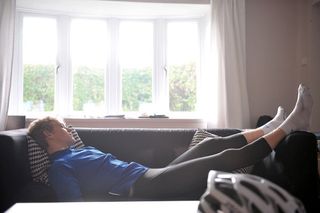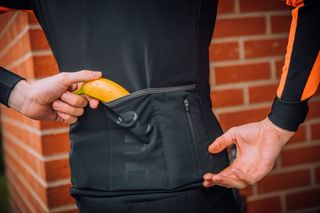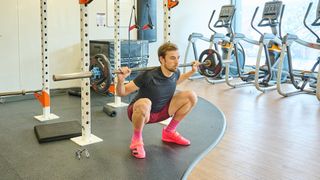My last race was the 2021 Tour of Britain; I held an Elite License and raced for a UCI team. Life has changed a lot since then, I’m now a full-time working 2nd cat, having spent several years battling long-Covid, mental health struggles, and learning to balance the bike alongside juggling several jobs – from wind tunnel technician to coach.
Last year, with my power numbers at an all time low, I decided it was time to get back on it. Now, I’ve set myself the goal of getting to the start line and having a respectable race.
The road back to my vision of ‘racing fitness’ has been a steep one, and I’m still climbing. Back in 2021, I was able to pack in about 70-90 hours a month. Now, it’s normally 20, or 30 on a good month. However, I’m starting to see results.
| Duration | 2021 – Elite level | 2023 – no training | 2024 – 12months hard work |
| 20min | 422w | 324w | 362w |
| 5min | 497w | 386w | 436w |
| 1min | 760w | 601w | 706w |
| 5sec | 1344w | 1149w | 1210w |
What I do have on my side, is a degree in sports and exercise sciences and years of coaching experience. So, with drastically reduced training hours, what have I done – so far – to regain fitness, how will I keep it up, and – most importantly – how can this approach help more amateur athletes to be their best on five to eight hours a week? Let’s dive in…
Optimising my training and time available
Quick fire hacks
Train smarter, not harder You don’t want to train harder than you need to, you have to balance the sum of all stresses and work according to that.
The turbo is your friend Indoors, you can complete quality interval sessions easily without disruptions, and there’s no cleaning involved
Set your bike position to you, not where you want to be All too often people set their bike up with the classic pro ‘long and low’, but this can lead to injuries and reduced performance. Adapt your fit based on where your body is along the training and conditioning process.
Don’t neglect off the bike work Stretching and S&C work will go a long way to reducing injury, improving performance, and being able to better maintain power while being aero.
Eat well and rest better If you don’t fuel the engine, the engine isn’t going to work at its best. Not only will fueling properly improve performance on the day, but it will also enhance recovery. Better recovery leads to better performance and training improvements.
The first big one is making better use of my time when it comes to training and being smart with it.
I used to train using the 80/20 rule – 80% of my time was spent riding easy, with just 20% including intensity. With fewer than 10 hours available, it makes more sense to adopt the ‘Pyramid’ approach: less time at lower intensities, and more time in the tempo/Sweetspot zones.
There are several different ways of becoming more aerobically fit, and they rely on very different pathways to do so. The goal of all of them is to stimulate the biogenesis of mitochondria – the “powerhouse of the cell” – that is responsible for breaking down substrates (fuel) and creating Adenosine triphosphate (ATP), which we use in every single muscle contraction. Broadly speaking, the more mitochondria we have, and the more effective they are, the more aerobically fit we can get.
The latest race content, interviews, features, reviews and expert buying guides, direct to your inbox!
Low intensity exercise over longer durations creates a stimulus via continuous muscle contractions. If this time is not available, we can instead switch to high intensity workouts, providing more bang for buck with the time we have.
I’ve opted for a mix Sweetspot (SS)/tempo and shorter VO2max and repeated efforts for several reasons. The SS/Tempo helps with maintaining higher power outputs over sustained periods of time and lactate shuttling, the VO2max work helps drive the maximal aerobic capacity and real peak race efforts, while the repeats help sustain peak HR and boost lactate clearance as well as recovery from accelerations such as in a race.
This does mean cutting out ‘long rides’ which I miss doing, but with the time available I can generally only fit in one a week. They are still helpful for driving aerobic fitness adaptations and fatigue resistance, but for those with limited time there are alternatives that will help you.
I also spend a lot more time on the turbo trainer now, since interval sessions are easier to complete indoors without distraction, and time cleaning the bike and setting up is limited.
Sleeping enough and focusing on smart recovery

So, why not maximise the hours available by just riding hard all the time? Because I wouldn’t be able to recover enough. Training, work, and other life factors all represent stressors. I used to train and rest, and work a little. Now I work a lot, train a little – I still require the same level of rest to overcome the sum of all stresses. Sure I can manage a week or so at a high training volume and not have any issues, but if I try and sustain that it impacts recovery significantly and I will burn out.
At times, I have felt that I’m not doing enough, especially compared to others. However, the key has been remaining objective: I know if I train more I can’t rest more. Whilst increases in fitness won’t be as rapid as they would if I had more time available, this method is far more sustainable.
I’ve also aimed to make my rest more effective. I used to scroll my phone on social media for hours at a time and just stimulate my mind too much, especially before bed. I now make a concerted effort to put my phone on ‘do not disturb’ after a certain time, wind down properly before bed, ensure that light and noise are limited, so that I can get as much quality out of my rest as possible. Sleep health has been a very important factor in allowing me to rest more in a given period of time, and therefore be able to train better and more consistently.
Don’t target weight loss – and avoid getting ill
When I was racing Elite level, I was a few kilograms lighter. However I was very susceptible to throat infections and had to be very careful to avoid getting ill. At times, I pushed the focus on weight too far for my height and build. Existing at a lower weight and hitting regular calorie deficits makes you more likely to get ill because your immune system can become less effective and less able to deal with external threats. And, illness means a big reduction in training consistency.
The fact of the matter is that although watts per kilo are important, the most important part of that equation are the watts. Let’s take a 100kg rider with a 400 watt FTP, and a 50kg rider with a 200 watt FTP. Same W/kg, but the 100kg rider will be faster on the flats and the downhills, and because of the effect of rolling resistance, for the same w/kg the rider with higher power will actually go uphill quicker too.
Additionally for me, I know I will get more out of a higher power output than getting lighter. I also will be less likely to get ill if I don’t focus on weight loss, and will be able to train more consistently and get stronger. Health and consistency should always be the key focus.
Fueling workouts properly

(Image credit: Future)
On the subject of staying healthy and powerful, another big focus has been my fueling and nutrition. I used to have a bad habit of not eating enough during training sessions. I’ve since learnt a lot more about how to fuel training effectively.
When I know I have an intense session coming up, I make sure to have a good carby meal 2-3 hours beforehand, and if that session is longer than an hour I will have energy drinks or gels to get me through it. On the road, when the session is 3 hours or more, I aim to consume about 80-100g of carbs every hour. Then when I’m back, it’s a case of eating something straight away that’s high in carbs and some protein.
The big benefit of fueling the sessions properly is three-fold. Firstly, I get a lot more out of the session. Secondly I feel less lethargic, my work is not negatively impacted by training. Thirdly, it helps massively with recovery for the next day and subsequent sessions.
Sports nutrition supplements aren’t cheap – but there are hacks available. Firstly, rather than energy bars go for fruit loaf/cake as it’s pretty easy to make this at home and cheap to do so. Alternatively, Maltloaf offers great value. Energy drinks are expensive too, but plain white sugar offers a good alternative, with a little salt and squash added for taste – just brush your teeth a couple of hours after your ride. As for recovery drinks, chocolate milk or rice pudding are great ways to get in a good amount of protein and carbohydrates for less money.
Functional strength and conditioning, body maintenance and bike fit

(Image credit: Future)
Cycling is a physically taxing sport, and ensuring your body is able to deal with the demands is important. Adding in strength and conditioning (S&C) work also carries performance gains – a 12 week S&C plan certainly boosted by watts.
Staying on top of strength training, stretching, and bike fit, can also offer ‘free’ gains. A more aerodynamic cyclist is a faster cyclist, and a big part of the aero equation is your frontal area. Working on being able to produce power while in an aerodynamic position is going to be far more performance enhancing than any aero bike and wheels. This is why I’ve done a lot of work on my posterior chain (back of legs, glutes, back and shoulders) to ensure good flexibility and stability, while also doing efforts in a more tucked in position to put power out while like that.
Bike fit is also a moving target – I’ve adjusted mine to account for where I’m at with my flexibility and training. Having specialised in biomechanics at university, I’m confident in my ability to fit myself, but spending £150-300 on a fit is a worthy investment, especially when integrated bar/stem combos cost upwards of £500 to change out!
Optimising equipment
The tech arms race is rife in cycling, so selecting the right equipment can be important. When it comes to the greatest return on investment, there are two things that stand out.
Firstly, a good fitting skinsuit: ~80% of all drag on a cyclist is from the body, so if you can reduce the impact of that drag it will help increase your speed more than a fancy new aero frame. You want to go for something that is the right size, as going too small actually makes most cycling garments more draggy thanks to exposed fibres.
The next investment is tyres. The difference between a good and a super tyre can be around 20 watts difference of rolling resistance. And this isn’t just during efforts or climbing, this is for the entire time the tire is in contact with the ground. My personal choice for tyres have been the Vittoria Corsa Pro Speed or Continental GP5000 TT given the low rolling resistance and high grip of them. However, they are only used for race days with more durable tires used for training.

















